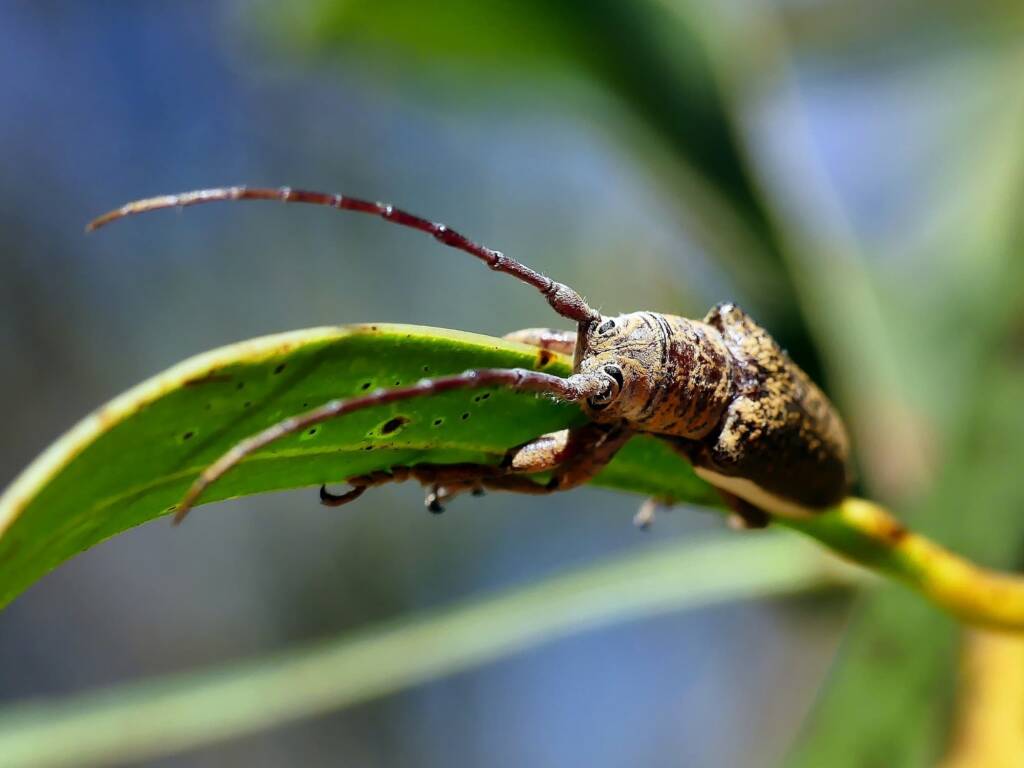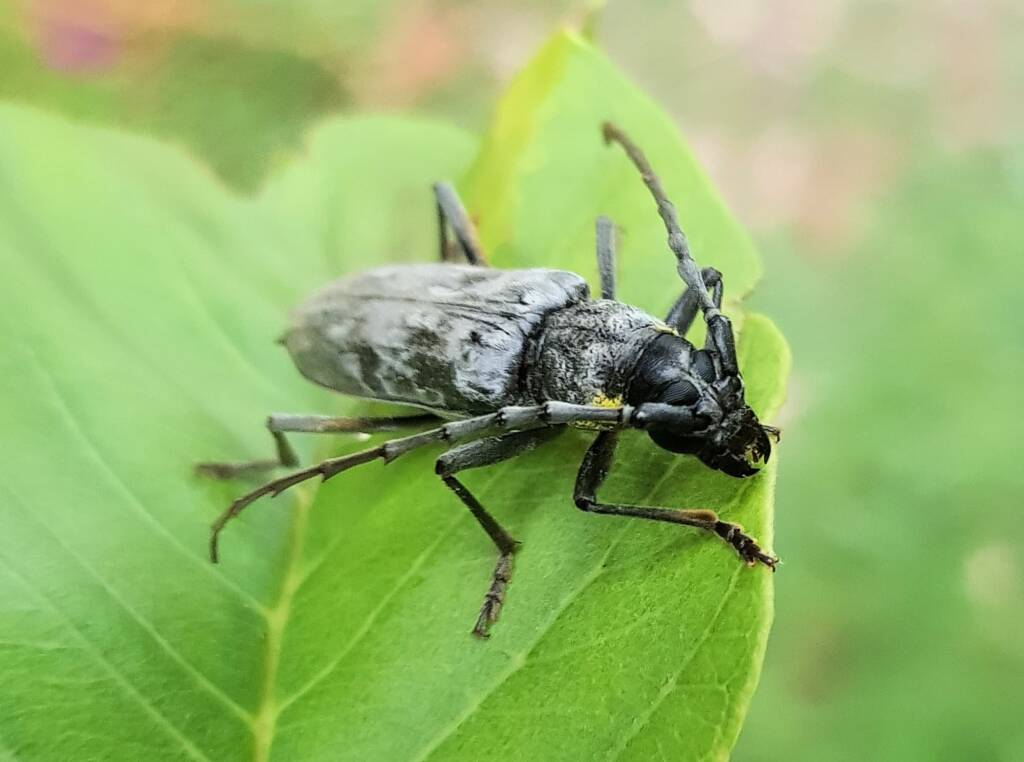ColeopteraAmarygmus sp Anoplognathus sp Aphanestes gymnopleura Buprestidae Cerambycidae Coleoptera (Beetles) Curculionidae Digitonthophagus gazella Dung Beetle Eretes australis Helea scaphiformis Johannica gemellata (Pandorea Leaf Beetle) Ladybirds (Beetles) Lepidiota Lucanidae Neospades sp Lycidae Omorgus Paropsine Beetle Paropsisterna sp Pittosporum Leaf Beetle (Lamprolina impressicollis) Protaetia fusca Pterohelaeus sp Rhipiceridae Scarabaeidae Xylophilostenus octophyllus
The Longhorn Beetles — from the family Cerambycidae are an easily recognised groups of beetles (in the adult form). Also knowns as Long-horned or Longicorns beetles and whose larvae are often referred to as roundheaded borers, are a large family encompassing more than 33,000 species worldwide, with some 1,400 species in 300 genera, that are native to Australia. It is the 6th largest, among 117 beetle families in Australia.

Most of the species are characterized by the long antennae, which can be as long as or longer than the body of the beetle. There are a few species that have short antennae (eg Neandra brunnea), making them difficult to distinguish from related families such as Chrysomelidae.
“Cerambycidae” comes from a Greek mythological figure, who after an argument with nymphs, the shepherd Cerambus is transformed into a large beetle with horns.

Another distinctive features of this group of beetles, besides the long antennal length, is that the antennal sockets are located on low tubercles on the face (other beetles with long antennae lack these tubercles), and cerambycids with short antennae also have these low tubercles on the face.

This group of beetles vary in size, shape, sculpture, and coloration. A majority of species in this group are cryptically coloured, meaning that they are camouflage, usually to blend in with their surroundings. Some longhorn species mimic ants, bees, and wasps.

Most Cerambycidae feed on living or dead plant tissues, with the larvae living and feeding on damaged or dead trees for their development.
They are an important part of saproxylic fauna (a group of saproxylic organisms that are a considerable part of forest biodiversity), which help to speed up the natural lifecycle of the terrestrial environments. Unfortunately many species are listed as pests because of their destructive role to the timber industry.

There is a great book three-volume series titled Australian Longhorn Beetles Series from CSIRO Publishing (see footnote/references below)
- ientific classification
- Kingdom: Animalia
- Phylum: Arthropoda
- Subphylum: Hexapoda
- Class: Insecta
- Informal: Pterygotes
- Order: Coleoptera
- Suborder: Polyphaga
- Superfamily: Chrysomeloidea
- Family: Cerambycidae
- Unranked:
- Monochamus
- Monochamus alternatus
- Monochamus galloprovincialis
- Monochamus scutellatus
- Monochamus sutor
- Monochamus titillator
- Subfamily:
- Cerambycinae
- Lamiinae
- Lepturinae
- Parandrinae
- Prioninae
- Spondylidinae
- Sphondylidinae
- Genus:
- Anoplophora
- Aristobia
- Trichoferus
(Source: Atlas of Living Australia)
- Scientific classification
- Kingdom: Animalia
- Phylum: Arthropoda
- Subphylum: Hexapoda
- Class: Insecta
- Informal: Pterygotes
- Order: Coleoptera
- Suborder: Polyphaga
- Superfamily: Chrysomeloidea
- Family: Cerambycidae
- Subfamily: Cerambycinae
- Tribe: Cerambycini
- Genus:
- Aeolesthes Gahan, 1890
- Pachydissus Newman, 1838
(Source: Atlas of Living Australia)
Footnote & References
- Cerambycidae, Atlas of Living Australia, https://bie.ala.org.au/species/https://biodiversity.org.au/afd/taxa/41240a49-8356-40c7-a73b-01ae3ac939c1
- Australian Longhorn Beetles Series from CSIRO Publishing, https://www.publish.csiro.au/books/series/72
- Australian Cerambycidae, CSIRO, https://www.ento.csiro.au/biology/cerambycidae/cerambycidae.html
- Pachydissus, Newman, CSIRO, https://www.ento.csiro.au/biology/cerambycidae/info_pages/Pachydissus.html
- All Longhorn beetle (Cerambycidae) sightings, Canberra Nature Map, https://canberra.naturemapr.org/categories/235
ColeopteraAmarygmus sp Anoplognathus sp Aphanestes gymnopleura Buprestidae Cerambycidae Coleoptera (Beetles) Curculionidae Digitonthophagus gazella Dung Beetle Eretes australis Helea scaphiformis Johannica gemellata (Pandorea Leaf Beetle) Ladybirds (Beetles) Lepidiota Lucanidae Neospades sp Lycidae Omorgus Paropsine Beetle Paropsisterna sp Pittosporum Leaf Beetle (Lamprolina impressicollis) Protaetia fusca Pterohelaeus sp Rhipiceridae Scarabaeidae Xylophilostenus octophyllus
InsectsBees Beetles Blattodea Butterflies Coleoptera Cicada Crabronidae Diptera Dragonflies & Damselflies Formicidae Hemiptera Heteroptera (True Bugs) Mango Planthopper Moths Orthoptera Orthopteroid Processionary Caterpillar Stink Bugs, Shield Bugs and Allies Syrphidae Wasps Water Scorpion (Laccotrephes tristis) Witchetty Grub
